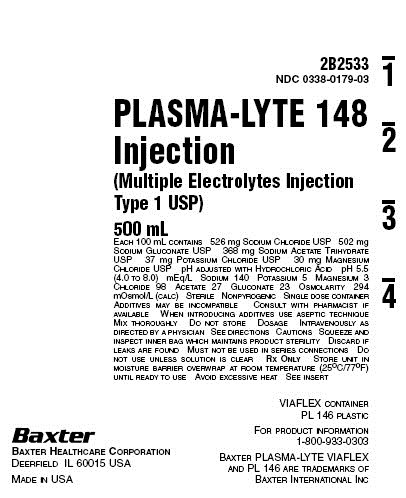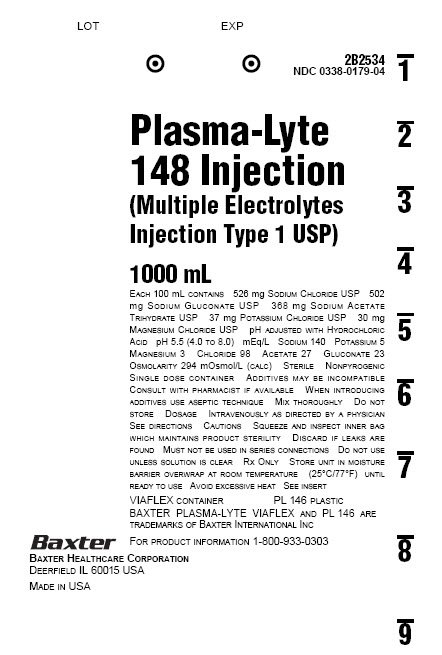Plasma-Lyte 148
PLASMA-LYTE 148 Injection (Multiple Electrolytes Injection, Type 1, USP)in VIAFLEX Plastic Container
7eee0bda-06d8-4cc4-85e9-7c6e4801f09c
HUMAN PRESCRIPTION DRUG LABEL
Aug 5, 2019
Baxter Healthcare Corporation
DUNS: 005083209
Products 1
Detailed information about drug products covered under this FDA approval, including NDC codes, dosage forms, ingredients, and administration routes.
SODIUM CHLORIDE, SODIUM GLUCONATE, SODIUM ACETATE, POTASSIUM CHLORIDE, AND MAGNESIUM CHLORIDE
Product Details
FDA regulatory identification and product classification information
FDA Identifiers
Product Classification
Product Specifications
INGREDIENTS (7)
Drug Labeling Information
PACKAGE LABEL.PRINCIPAL DISPLAY PANEL
PACKAGE LABEL - PRINCIPAL DISPLAY PANEL

500 mL Container Label
500 mL Container Label
2B2533
NDC 0338-0179-03
PLASMA-LYTE 148
Injection
(Multiple Electrolytes Injection
Type 1 USP)
500 mL
EACH 100 mL CONTAINS 526 mg SODIUM CHLORIDE USP 502 mg
SODIUM GLUCONATE USP 368 mg SODIUM ACETATE TRIHYDRATE
USP 37 mg POTASSIUM CHLORIDE USP 30 mg MAGNESIUM
CHLORIDE USP pH ADJUSTED WITH HYDROCHLORIC ACID pH 5.5
(4.0 TO 8.0) mEq/L SODIUM 140 POTASSIUM 5 MAGNESIUM 3
CHLORIDE 98 ACETATE 27 GLUCONATE 23 OSMOLARITY 294
mOsmol/L (CALC) STERILE NONPYROGENIC SINGLE DOSE CONTAINER
ADDITIVES MAY BE INCOMPATIBLE CONSULT WITH PHARMACIST IF
AVAILABLE WHEN INTRODUCING ADDITIVES USE ASEPTIC TECHNIQUE
MIX THOROUGHLY DO NOT STORE DOSAGE INTRAVENOUSLY AS
DIRECTED BY A PHYSICIAN SEE DIRECTIONS CAUTIONS SQUEEZE AND
INSPECT INNER BAG WHICH MAINTAINS PRODUCT STERILITY DISCARD IF
LEAKS ARE FOUND MUST NOT BE USED IN SERIES CONNECTIONS DO
NOT USE UNLESS SOLUTION IS CLEARRX ONLYSTORE UNIT IN
MOISTURE BARRIER OVERWRAP AT ROOM TEMPERATURE (25**°C/77°**F)
UNTIL READY TO USE AVOID EXCESSIVE HEAT SEE INSERT
VIAFLEX CONTAINER
PL 146 PLASTIC
FOR PRODUCT INFORMATION
1-800-933-0303
BAXTER PLASMA-LYTE VIAFLEX
AND PL 146 ARE TRADEMARKS OF
BAXTER INTERNATIONAL INC
Baxter logo
BAXTER HEALTHCARE CORPORATION
DEERFIELD IL 60015 USA
MADE IN USA

1000 mL Container Label
1000 mL Container Label
LOT
EXP
2B2534
NDC 0338-0179-04
Plasma-Lyte
148 Injection
(Multiple Electrolytes
Injection Type 1 USP)
1000 mL
EACH 100 mL CONTAINS 526 mg SODIUM CHLORIDE USP 502
mg SODIUM GLUCONATE USP 368 mg SODIUM ACETATE
TRIHYDRATE USP 37 mg POTASSIUM CHLORIDE USP 30 mg
MAGNESIUM CHLORIDE USP pH ADJUSTED WITH HYDROCHLORIC
ACID pH 5.5 (4.0 TO 8.0) mEq/L SODIUM 140 POTASSIUM 5
MAGNESIUM 3 CHLORIDE 98 ACETATE 27 GLUCONATE 23
OSMOLARITY 294 mOsmol/L (CALC) STERILE NONPYROGENIC
SINGLE DOSE CONTAINER ADDITIVES MAY BE INCOMPATIBLE
CONSULT WITH PHARMACIST IF AVAILABLE WHEN INTRODUCING
ADDITIVES USE ASEPTIC TECHNIQUE MIX THOROUGHLY DO NOT
STORE DOSAGE INTRAVENOUSLY AS DIRECTED BY A PHYSICIAN
SEE DIRECTIONS CAUTIONS SQUEEZE AND INSPECT INNER BAG
WHICH MAINTAINS PRODUCT STERILITY DISCARD IF LEAKS ARE
FOUND MUST NOT BE USED IN SERIES CONNECTIONS DO NOT USE
UNLESS SOLUTION IS CLEAR RX ONLY STORE UNIT IN MOISTURE
BARRIER OVERWRAP AT ROOM TEMPERATURE (25°C/77°F) UNTIL
READY TO USE AVOID EXCESSIVE HEAT SEE INSERT
VIAFLEX CONTAINER PL 146 PLASTIC
BAXTER PLASMA-LYTE VIAFLEX AND PL 146 ARE
TRADEMARKS OF BAXTER INTERNATIONAL INC
FOR PRODUCT INFORMATION 1-800-933-0303
Baxter logo
BAXTER HEALTHCARE CORPORATION
DEERFIELD IL 60015 USA
MADE IN USA
ADVERSE REACTIONS SECTION
ADVERSE REACTIONS
Post-marketing Adverse Reactions
The following adverse reactions associated with the use of PLASMA-LYTE 148 Injection (Multiple Electrolytes Injection, Type 1, USP) were identified in clinical trials or postmarketing reports. Because postmarketing reactions were reported voluntarily from a population of uncertain size, it is not always possible to estimate their frequency, reliably, or to establish a causal relationship to drug exposure.
Hypersensitivity and Infusion Reactions: tachycardia, palpitations, chest pain, chest discomfort, dyspnea, flushing, hyperemia, asthenia, feeling abnormal, piloerection, edema peripheral, pyrexia, hypotension, wheezing, urticaria, cold sweat, chills.
General Disorders and Administration Site Conditions: infusion site pain, burning sensation.
Metabolism and nutrition disorders: hyperkalemia, hyponatremia.
Nervous System Disorders: hyponatremic encephalopathy.
Overdose
Excessive administration of PLASMA-LYTE 148 Injection (Multiple Electrolytes Injection, Type 1, USP) can cause:
•
fluid overload with a risk of edema (peripheral and/or pulmonary), particularly when renal sodium excretion is impaired.
•
hypernatremia and hyperkalemia, especially in patients with severe renal impairment.
•
hypermagnesemia. See**WARNINGS** and**ADVERSE REACTIONS**
•
metabolic alkalosis with or without hypokalemia and decreased ionized serum calcium and magnesium concentrations.
When assessing an overdose, any additives in the solution must also be considered.
The effects of an overdose may require immediate medical attention and treatment.
Interventions include discontinuation of PLASMA-LYTE 148 Injection (Multiple Electrolytes Injection, Type 1, USP), dose reduction, and other measures as indicated for the specific clinical constellation (e.g., monitoring of fluid balance, electrolyte concentrations and acid base balance).
PRECAUTIONS SECTION
PRECAUTIONS
Patients with Renal Impairment
In patients with renal impairment, administration of PLASMA-LYTE 148 Injection (Multiple Electrolytes Injection, Type 1, USP) may result in sodium and/or potassium or magnesium retention (seeWARNINGS). Avoid PLASMA-LYTE 148 Injection (Multiple Electrolytes Injection, Type 1, USP) in patients with severe renal impairment or conditions that may cause sodium and/or potassium retention or magnesium retention, fluid overload, or edema. If use cannot be avoided, monitor patients with severe renal impairment for development of these adverse reactions.
Drug Interactions
Other Products that Affect Fluid and/or Electrolyte Balance
Administration of PLASMA-LYTE 148 Injection (Multiple Electrolytes Injection, Type 1, USP) to patients treated concomitantly with drugs associated with sodium and fluid retention may increase the risk of hypernatremia and volume overload. Avoid use of PLASMA-LYTE 148 Injection (Multiple Electrolytes Injection, Type 1, USP) in patients receiving such products, such as corticosteroids or corticotropin. If use cannot be avoided, monitor serum electrolytes, fluid balance and acid-base balance.
Other Drugs that Increase the Risk of Hyponatremia
Administration of PLASMA-LYTE 148 Injection (Multiple Electrolytes Injection, Type 1, USP) in patients treated concomitantly with medications associated with hyponatremia may increase the risk of developing hyponatremia.
Avoid use of PLASMA-LYTE 148 Injection (Multiple Electrolytes Injection, Type 1, USP) in patients receiving products, such as diuretics, and certain antiepileptic and psychotropic medications. Drugs that increase the vasopressin effect reduce renal electrolyte free water excretion and may also increase the risk of hyponatremia following treatment with intravenous fluids. If use cannot be avoided, monitor serum sodium concentrations.
Lithium
Renal clearance of lithium may be increased during administration of PLASMA- LYTE 148 Injection (Multiple Electrolytes Injection, Type 1, USP). Monitor serum lithium concentrations during concomitant use.
Other Products that Increase the Risk of Hyperkalemia
Because of its potassium content, avoid use of PLASMA-LYTE 148 Injection (Multiple Electrolytes Injection, Type 1, USP) in patients receiving products that can cause hyperkalemia or increase the risk of hyperkalemia, such as potassium sparing diuretics, ACE inhibitors, angiotensin II receptor antagonists, or the immunosuppressants tacrolimus and cyclosporine. If use cannot be avoided, monitor serum potassium concentrations.
Drugs with pH Dependent Renal Elimination
Due to its alkalinizing effect (formation of bicarbonate), PLASMA-LYTE 148 Injection (Multiple Electrolytes Injection, Type 1, USP) may interfere with the elimination of drugs with pH dependent renal elimination. Renal clearance of acidic drugs may be increased. Renal clearance of alkaline drugs may be decreased.
Drug/Laboratory Test Interactions
There have been reports of positive test results using the Bio-Rad Laboratories Platelia Aspergillus EIA test in patients receiving Baxter gluconate containing PLASMA-LYTE solutions. These patients were subsequently found to be free of Aspergillus infection. Therefore, positive test results for this test in patients receiving Baxter gluconate containing PLASMA-LYTE solutions should be interpreted cautiously and confirmed by other diagnostic methods.
Carcinogenesis, Mutagenesis, Impairment of Fertility
Studies with PLASMA-LYTE 148 Injection (Multiple Electrolytes Injection, Type 1, USP) have not been performed to evaluate carcinogenic potential, mutagenic potential, or effects on fertility.
Pregnancy
Teratogenic Effects
Animal reproduction studies have not been conducted with PLASMA-LYTE 148 Injection (Multiple Electrolytes Injection, Type 1, USP). It is also not known whether PLASMA-LYTE 148 Injection (Multiple Electrolytes Injection, Type 1, USP) can cause fetal harm when administered to a pregnant woman or can affect reproduction capacity. PLASMA-LYTE 148 Injection (Multiple Electrolytes Injection, Type 1, USP) should be given to a pregnant woman only if clearly needed.
Nursing Mothers
It is not known where this drug is excreted in human milk. Because many drugs are excreted in human milk, caution should be exercised when PLASMA-LYTE 148 Injection (Multiple Electrolytes Injection, Type 1, USP) is administered to a nursing mother.
Pediatric Use
The use of PLASMA-LYTE 148 Injection (Multiple Electrolytes Injection, Type 1, USP) in pediatric patients is based on clinical practice.
Geriatric Use
Geriatric patients are at increased risk of developing electrolyte imbalances. PLASMA-LYTE 148 Injection (Multiple Electrolytes Injection, Type 1, USP) is known to be substantially excreted by the kidney, and the risk of toxic reactions to this drug may be greater in patients with impaired renal function. Therefore, dose selection for an elderly patient should be cautious, usually starting at the low end of the dosing range, reflecting the greater frequency of decreased hepatic, renal, or cardiac function, and of concomitant disease or other drug therapy. Consider monitoring renal function in elderly patients
HOW SUPPLIED SECTION
HOW SUPPLIED
PLASMA-LYTE 148 Injection (Multiple Electrolytes Injection, Type 1, USP) in VIAFLEX plastic containers is available as shown below:
|
Code |
Size |
NDC |
|---|---|---|
|
2B2534 |
1000 |
NDC 0338-0179-04 |
|
2B2533 |
500 |
NDC 0338-0179-03 |
Exposure of pharmaceutical products to heat should be minimized. Avoid excessive heat. It is recommended the product be stored at room temperature (25°C); brief exposure up to 40°C does not adversely affect the product.
